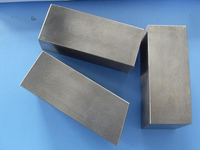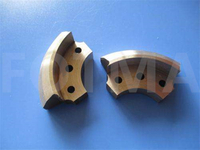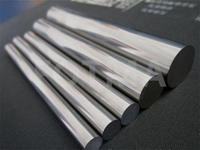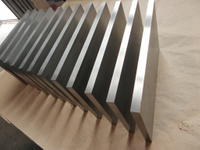Views: 16 Author: Site Editor Publish Time: 2022-05-16 Origin: Site
Tungsten steel, also known as cemented carbide, refers to a sintered composite material containing at least one metal carbide. Tungsten carbide, titanium carbide, and tantalum carbide are common components of tungsten steel. The grain size of the carbide component (or phase) is typically between 0.2-10 microns, and the carbide grains are held together using a metallic binder. The binder is usually referred to as the metal cobalt (Co), but for some special applications, nickel (Ni), iron (Fe), or other metals and alloys may also be used. A compositional combination of carbide and binder phase to be determined is referred to as a "grade". The classification of tungsten steel is carried out according to ISO standards. This classification is based on the material type of the workpiece (eg P, M, K, N, S, H grades). The binder phase composition is mainly used for its strength and corrosion resistance.
The matrix of tungsten steel consists of two parts: one part is the hardening phase; the other part is the bonding metal. Binder metals are generally iron group metals, commonly cobalt, nickel and titanium. Therefore, there are tungsten-cobalt alloys, tungsten-nickel alloys and tungsten-titanium-cobalt alloys.
Tungsten-cobalt alloy, also known as tungsten carbide-cobalt tungsten steel, is a tungsten steel composed of tungsten carbide and metallic cobalt. According to the cobalt content, it can be divided into three categories: high cobalt (20% to 30%), medium cobalt (10% to 15%) and low cobalt (3% to 8%). The grades of this type of tungsten steel produced in China are YG6, YG8, YG6X, YG10C, etc. The letters "YG" indicate "WC-Co", the numbers after "G" indicate the content of Co, "X" indicates fine grains, and "C" indicates coarse grains.
Such cermets generally increase their flexural strength and fracture toughness with increasing cobalt content, while their hardness decreases. Tungsten-cobalt alloy has high flexural strength, compressive strength, impact toughness, elastic modulus and small thermal expansion coefficient, and is the most widely used type of tungsten steel. As a tool, it can process cast iron, non-ferrous metals, non-metals, heat-resistant alloys, titanium alloys and stainless steel, etc., and can also be used as extension dies, wear-resistant parts, stamping dies and drills.
Nickel-based alloy is a kind of tungsten steel alloy with metal nickel as the matrix, which has the characteristics of high melting point, high hardness and high corrosion resistance. Widely used in industrial work molds and so on.
Tungsten-titanium-cobalt tungsten steel, the main components are tungsten carbide, titanium carbide (TiC) and cobalt. Its grade is composed of "YT" ("hard, titanium" two characters in Chinese Pinyin prefix) and the average content of titanium carbide. For example, YT15 means the average WTi=15%, and the rest is tungsten-titanium-cobalt tungsten steel with tungsten carbide and cobalt content.
Depending on the content of the binder metal, the properties of the formed tungsten steel (hard alloy) are also different. Usually, the density of tungsten steel is about 14~15 g/cm3, the hardness is HRA 86~93, which is equivalent to HRC 69~81; the bending strength is about 2000~4000 N/mm2. The particles are divided into ultra-fine particles, fine particles, medium particles and coarse particles. Generally, the hardness of tungsten steel with fine particles is relatively high.
Tungsten steel sintering is to press the powder into a billet, then enter the sintering furnace to heat to a certain temperature (sintering temperature), keep it for a certain time (holding time), and then cool it down to obtain the tungsten steel material with the required properties. Tungsten steel (tungsten carbide) is widely used as tool material, such as turning tools, milling cutters, planers, drills, boring tools, etc., for cutting cast iron, non-ferrous metals, plastics, chemical fibers, graphite, glass, stone and ordinary steel. It can be used to cut heat-resistant steel, stainless steel, high manganese steel, tool steel and other difficult-to-machine materials. Adding a small amount of elements to tungsten steel can strengthen the hard phase and binder phase of the material, purify the grain boundaries and significantly improve the flexural strength and impact toughness of the material.





